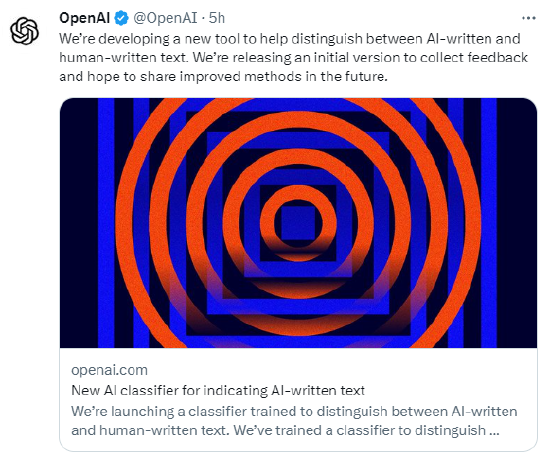Morning news on February 1, Beijing time, it was reported that the American artificial intelligence company OpenAI had launched the popular chat or writing robot product ChatGPT in the past. Today, the company announced in an official blog post that it has launched a new tool that can identify whether some text is written by artificial intelligence software.

The tool ChatGPT was launched in November last year and immediately became popular on the Internet and was praised and welcomed by users. Users can enter some prompt text, and this tool can write various articles, essays, jokes, and even poetry. However, this artificial intelligence writing software has also raised questions about copyright and plagiarism.
OpenAI's newly launched product is called "AI classifier". The language model used by this software has been trained on a large number of human manuscripts and artificial intelligence manuscripts on the same topic, and can identify whether a certain manuscript is Written by humans or generated by artificial intelligence software.
OpenAI said that this product integrates technology from multiple suppliers and can be used to solve various real-world problems, such as software robots spreading false information crazily on social media and misconduct in writing academic papers.
This product is still in the beta stage. OpenAI stated that the recognition performance of the tool is not very stable for articles less than 1,000 characters. In addition, articles written by artificial intelligence can deceive AI classifiers after being edited by humans.
The company said it will let the public use this new product, hoping to get some feedback from users on whether such an imperfect artificial intelligence product can produce some practical uses.
The company said that in the school education industry, the development team realized that identifying articles ghostwritten by students using artificial intelligence software is a very important topic. It is also important to understand what the AI classifier has to do with identifying student articles. deficiencies and what impact they will have.
Since ChatGPT became popular on the Internet and received likes from millions of users, it has triggered alarm in some school districts in the United States. School districts, including New York City, have announced that they will ban students from using this artificial intelligence writing tool. They are worried that students will use this tool to write articles to deceive teachers or commit plagiarism.
In order to help teachers and schools identify whether students' articles are written by artificial intelligence, identification tools developed by third parties have emerged in the industry, including "GPTZeroX".
OpenAI stated that they are actively communicating with the education industry to discuss the uses or limitations of ChatGPT, and will continue to develop and improve tools for identifying articles written by artificial intelligence.
Previous article:Mouser Electronics adds more than 55 new suppliers in 2022 to further expand product distribution lineup
Next article:Qorvo® wins Honor’s 2022 Gold Supplier Award
- Popular Resources
- Popular amplifiers
- e-Network Community and NXP launch Smart Space Building Automation Challenge
- The Internet of Things helps electric vehicle charging facilities move into the future
- Nordic Semiconductor Launches nRF54L15, nRF54L10 and nRF54L05 Next Generation Wireless SoCs
- Face detection based on camera capture video in OPENCV - Mir NXP i.MX93 development board
- The UK tests drones equipped with nervous systems: no need to frequently land for inspection
- The power of ultra-wideband: reshaping the automotive, mobile and industrial IoT experience
- STMicroelectronics launches highly adaptable and easy-to-connect dual-radio IoT module for metering and asset tracking applications
- This year, the number of IoT connections in my country is expected to exceed 3 billion
- Infineon Technologies SECORA™ Pay Bio Enhances Convenience and Trust in Contactless Biometric Payments
- LED chemical incompatibility test to see which chemicals LEDs can be used with
- Application of ARM9 hardware coprocessor on WinCE embedded motherboard
- What are the key points for selecting rotor flowmeter?
- LM317 high power charger circuit
- A brief analysis of Embest's application and development of embedded medical devices
- Single-phase RC protection circuit
- stm32 PVD programmable voltage monitor
- Introduction and measurement of edge trigger and level trigger of 51 single chip microcomputer
- Improved design of Linux system software shell protection technology
- What to do if the ABB robot protection device stops
- Pickering Launches New Future-Proof PXIe Single-Slot Controller for High-Performance Test and Measurement Applications
- Apple faces class action lawsuit from 40 million UK iCloud users, faces $27.6 billion in claims
- Apple faces class action lawsuit from 40 million UK iCloud users, faces $27.6 billion in claims
- The US asked TSMC to restrict the export of high-end chips, and the Ministry of Commerce responded
- The US asked TSMC to restrict the export of high-end chips, and the Ministry of Commerce responded
- ASML predicts that its revenue in 2030 will exceed 457 billion yuan! Gross profit margin 56-60%
- Detailed explanation of intelligent car body perception system
- How to solve the problem that the servo drive is not enabled
- Why does the servo drive not power on?
- What point should I connect to when the servo is turned on?
- Please tell me the advantages and disadvantages of these two differential signal amplifications
- msp430 contains ADC12 module program implementation
- This circuit for detecting mobile phones is no longer usable, right?
- STM32 stepper motor trapezoidal acceleration and deceleration program
- What is the way to distinguish whether series resonance is good or bad?
- [2022 Digi-Key Innovation Design Competition] Material Unboxing - ESP32-S2-KALUGA-1
- stm32 does not recognize chip ID using keil+stlink
- I would like to recommend a domestic MCU Gaojing GOF to replace STM32F103C8T6
- 6 Elements of Brushless DC Motor Control
- Introduction to the mobile station development board: Air 720D Micropython nano development board

 3582J
3582J












 京公网安备 11010802033920号
京公网安备 11010802033920号